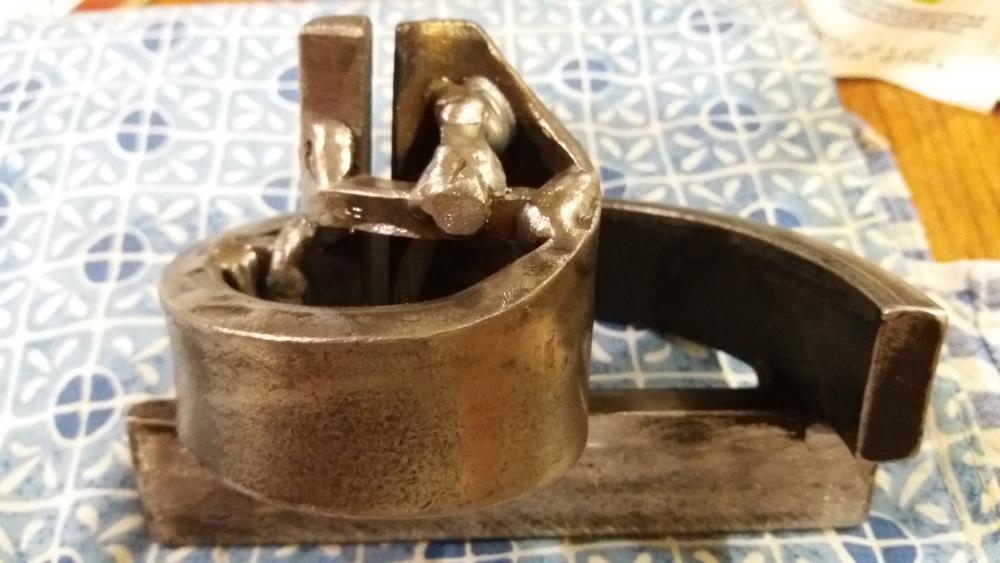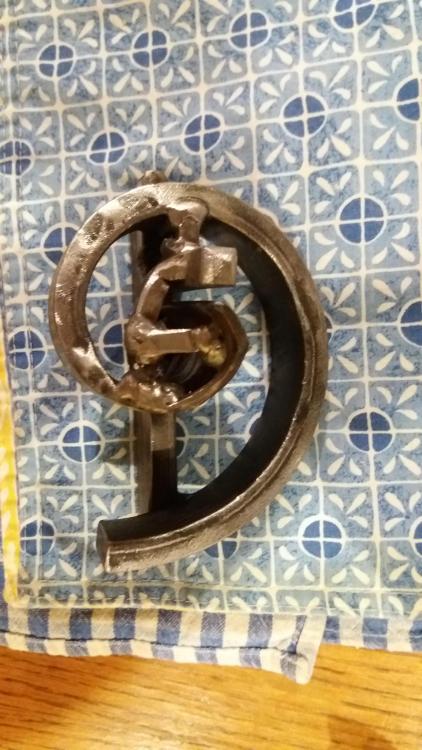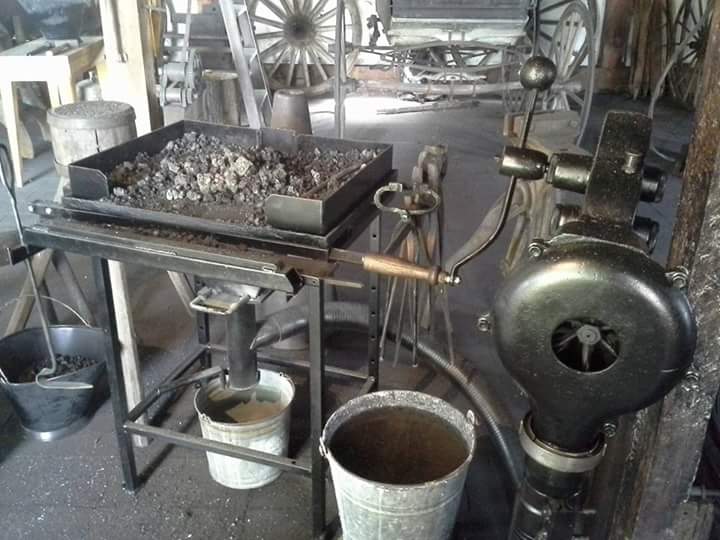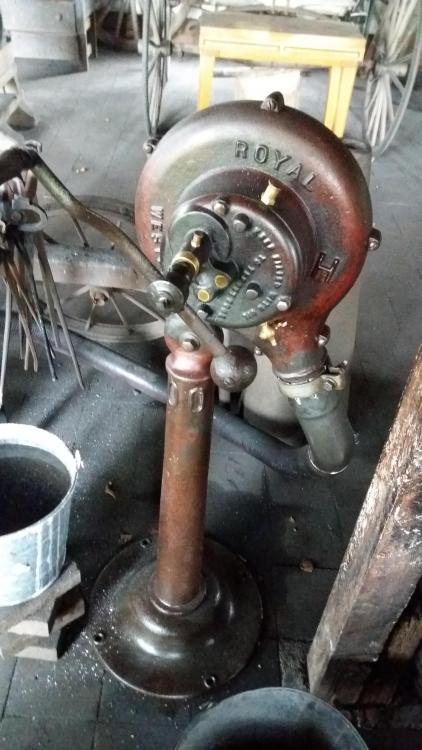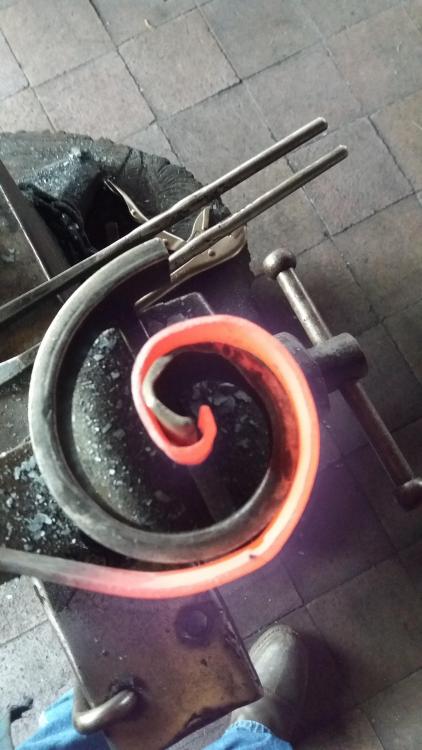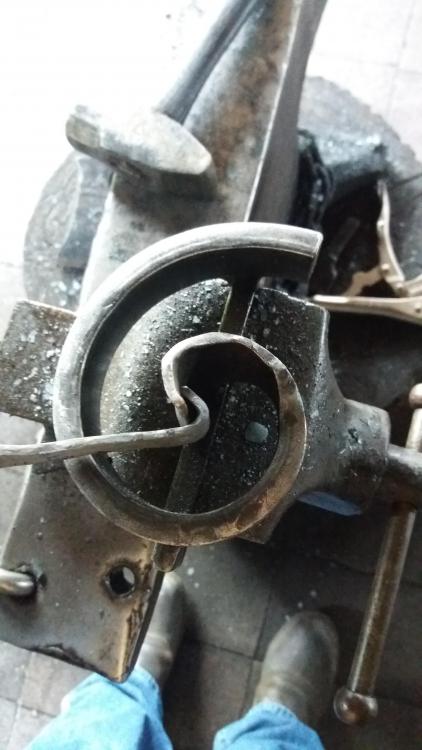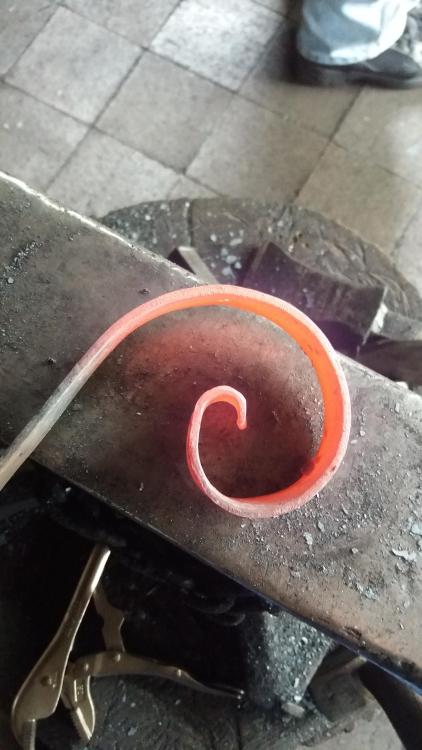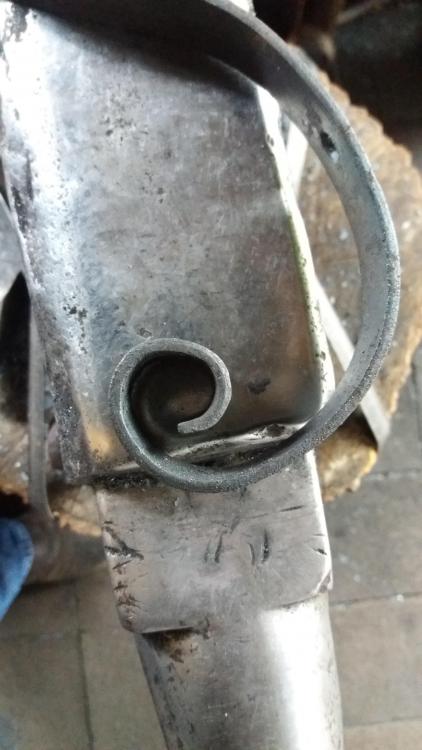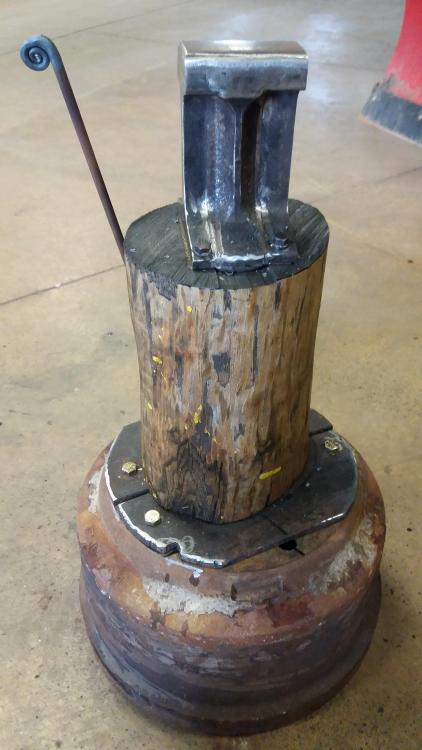-
Posts
1,227 -
Joined
-
Last visited
Content Type
Profiles
Forums
Articles
Gallery
Downloads
Events
Everything posted by SReynolds
-

Mission Impossible W/Pictures
SReynolds replied to SReynolds's topic in Blacksmithing, General Discussion
Pics of the modified scrolling jig. It almost works like it should. Not sure what else can be done but time will tell. -
That is exactly how i forge blunt tapers. I have not seen any bottom fullers outside of what is commonly seen. They are as wide as the hardie shank and quite long. About three times long as wide. And rather short.......
-
It has been posted/presented on this site many a time; right handed/your anvil horn to your left. Left handed/your anvil horn to right. Now I'm reading differently in this thread. I dont subscribe to either method. I do what I desire. Two anvils each opposite one another. I have many suggestions from visitors and they must have good reason for me to change such as; if your anvil horn points south on a Friday, the heel will break off. Until I hear something to the effect, i will operate my blower with dominate hand and point the horn where I feel like.
-
The block hardie is reference only That is what the work piece looks like when i finished the hardie shank process. Then I hold the work by way of the shank and forge the top into a bottom fuller. I need to try a different method when forging. That of laying it on the side and forging out the sides.
-
Yes. I think. I don't know..... I'm visualizing laying it on a side. It don't matter at the start as it be square. Then drawing it to widen it, Not make it taller, rather wider. Difficult to explain. It works but looks like a rounded cut-off hardie and bottom fullers dont look like that. The overall width should be as wide as the hardie square shank but three times longer. Like the above picture of the bottom fuller. Wide as the shank. But three times longer. Not taller.....longer. I dont have my bottom fuller to take a pic of.
-
I use them as well. Quite nice, if you have one that is well cared for. Otherwise they sound like a rock crusher. A friend just bought a 12" 400 for his brake drum forge for 250.00 I thought the idea of a brake drum forge was cost. They are nearly free to build. So a 250.00 blower on a brake drum is akin to .......well....something I'm sure!
-
I began with 2" x2" x 4" long. I drew the hardie shank and fit that to anvil. Not a challenge. But when I forged the top section; taper it and round the top to form the fuller, the tool is tall and narrow. Not like a fuller which are slender and long. My work looked like the top photo when I began to forge the taper. But i wanted it to look like the bottom photo. How should i have drawn out the top section to provide width? It works fine as is. But looks like a cut-off hardie with a rounded top (as opposed to a knife-like edge) I hope I'm making some sense.......however.....the forum-site will now swap the photos so nothing i have said will make sense. Very strange website.
-
There is to be end (axial) play in the fan shaft. But not radial.
-

Mission Impossible W/Pictures
SReynolds replied to SReynolds's topic in Blacksmithing, General Discussion
Thanks guys. I'm gonna have to revamp this unit to save it. -

Mission Impossible W/Pictures
SReynolds replied to SReynolds's topic in Blacksmithing, General Discussion
Thanks Was wondering if i could cool it off But was making other projects today and had an apprentice to watch and work with and visitors to the shop and had to leave for 1.5 hour to get some tools and no time to experiment any further........ -
Mine. In the shop. Looking at blowers today at the farrier supply i found one canedy otto. Just like mine/yours. Gunky. But smooth. However; the crank arm was literally arc welded to the shaft. Asking 250.00 for it. I still hate you
-

Mission Impossible W/Pictures
SReynolds replied to SReynolds's topic in Blacksmithing, General Discussion
I tried both and no go. For instance; vise-grips or a pair-o-tongs........you have to hold the piece in place and scroll the workpiece AROUND the jaw of vise grips or tongs. Right? Then reform the scroll. But you cannot. Because the inner section is the inner section. There is no access to it. Its inside. Maybe if there was a video of somebody using a scroll jig...... I'm a welder/fabricator. I can simply modify this to allow strap steel to lock in place. I was taught by a blacksmith how to make scrolling jigs. And they employ a self-lock feature aka the "back-up" post. But i have to do it at work on my lunch hour. -
Learned how to make "hand made" scrolled candle holders. Problem; it takes many many hours to tweak, adjust and fit the scroll just so, it isn't possible for me to continue making them (for sale) as I spend approx. 12 hours forging per month for only 7 months a year. Not a typo. 12 hours per month. So i bought a commercially available scrolling jig fixture.............Epic Fail. It is trash. I cannot, for the life of me , figure how to use this to scroll flat stock. How on the planet , fo you hold the flat stock to the jig? Maybe I'm not explaining myself properly. There must be a manner, in which to attatch the flat stock to the jig in order for the stock to conform to said jig. I tried tongs and vise-grips. They are in the way of the scroll jig. I make many a scrolling jig myself and employ a post of which the stock butts up against, thus holding fast (tight) to the jig. Locking workpiece in place. This commercial jig has no method in which to lock the work piece to said jig fixture. The top two pics clearly show my attempt to use the scroll. Attempting to begin the scroll is impossible. The work must be held in place with a hammer as i attempt to follow the circumference of jig. The third pic is a scroll with the funky looking inner end bent strangely and quite unacceptable. The final picture is that of a hand made scroll from a scrolling fork. Quite nice. Should i modify the scrolling fixture to employ a locking/backup post? If so, why is this commercially available trash available and sold? I can make better and i dont even know what I'm doing. But thst takes precious time.
-
Probably said 125.00 and you said 95.00 I hate you. Exactly like mine; late model. I left mine all original. Gold paint and all. I keep her wiped down with diesel fuel. I just cannot bring myself to cover that original paint with Krylon. Not many are in nice original condition.
-

should I grind off the top 1/2 inch ?
SReynolds replied to yt12's topic in Anvils, Swage Blocks, and Mandrels
In all seriousness; do any of you regulars on this site know and understand that the common word on the street , that is to say YouTube , is exactly that? "Grind off the top to reface it" You guys can get a little harsh in your responses. Please understand, this is what the public is spewing. Folks stumble in here and you be " Dont %@#!*^#:*$ that anvil " !!!! -

What kind of steel is this?
SReynolds replied to setlab's topic in Blacksmithing, General Discussion
We have all been there. Buy only the besy quality junk steel. Or just buy new. Then you know it works! Are there any folks forging and selling hammers made from scrap? -

using normal wood
SReynolds replied to mrkiddi's topic in Solid Fuels: Coal, Coke, Charcoal, Wood, etc
I pertty much explain the process to visitors concerning coal to coke aka breeze vs other solid fuels available. Never tried wood. I used to buy hardwood blocks, about 4" x 1"x1" for fire starters and never thought to try them in the forge as fuel source. I may have to look for any leftover stash and try it. -

Woo Hoo! I'm ready to start smithing
SReynolds replied to Arkham's topic in Blacksmithing, General Discussion
I like a left handed set up. Work well for me as i dont swap tongs from right to left. -

using normal wood
SReynolds replied to mrkiddi's topic in Solid Fuels: Coal, Coke, Charcoal, Wood, etc
Yes. Sir. Try buying a coal forge for the price of the large wood forge! All you'd take home of a Champion or Candy Otto etc for that is a rusty old pan and forge blower in need of TLC -
Twenty times that of electric blower. Hope your auctioneer don't know it.You are in luck if it be a late model. The early versions are identified by a single line on gear case "fill to air cock" where late versions have two separate lines of verbage. I don't recall at moment. The early version has that problematic plastic resin gear. And you make a gear for it. Oh, just remembered; the late model gear case has an oil cup on the input shaft boss. The early version will not. Good luck. These babies are real nice. No ball bearings growling at you. If you wanna have a conversation and operate an old crank blower, this is your ticket to ride. Otherwise; dont speak to me untill i get this workpiece hot with my growling blower. I paid 300.00 for mine which is a late model with the factory stand, in all original condition. It is smoother than a Carpenters song.
-
I was instructed to make nails on the sharp edge of an anvil. Very effective. When i say sharp i don't mean zero radius but rather a very small/tight radius. Upon using an anvil which possesses beat up/worn out edges i have to emoy use of a hardie tool/block. Still servicable anvil but may require additional tooling. Nothing wrong with additional tooling. Blacksmith depot sells a version of a hardie block just for such purpose. Sometimes you gotta have a crisp/tight radius when fullering. I have a small anvil I use atop the very worn Trenton. Mounted to a hardie shank. I can leave that anvil in place and use its own hardie tooling while it remains securely mounted in the big anvil hardie hole.
-
I read on Brian B's website; the first item the students make is a pair of tongs. .........I really have no answer for that.
-
Try that. Thanks. Most folks ask the weight. And so without knowing, i make it up. I can see one quite well. For a 100 year old anvil that is. The other; only the bottom of the elongated dimond.
-
Two Trentons in the shop. Both of the serial numbers were utalized as a forging surface. Is that odd or normal? Folks seem to be able to read their serial number just fine. The weight stamp is also illedgabl although one anvil clearly has two weight numbers stamped in same location. As if it was stamped. Then the guy changed his mind and restamped it.
-

Finally managed to get an Anvil
SReynolds replied to Northumbrian's topic in Anvils, Swage Blocks, and Mandrels
This is how i mount anvils. The size of the log will change in relation to the anvil. But the theory is same. I can roll around a very heavy anvil. The base is a brake drum. 16.5 inch dia. 11-1/4" tall. The flange is 14" dia. Just mounted this RR Track makeshift anvil for a specific purpose.

